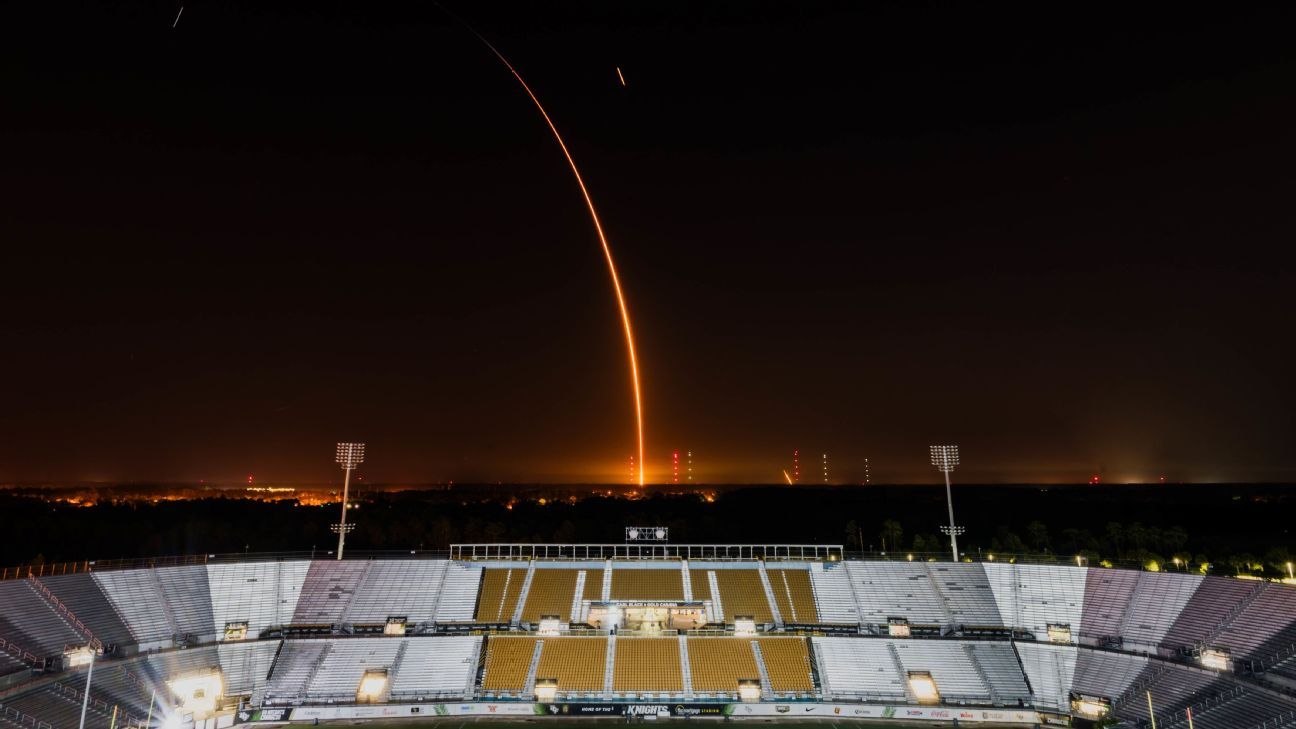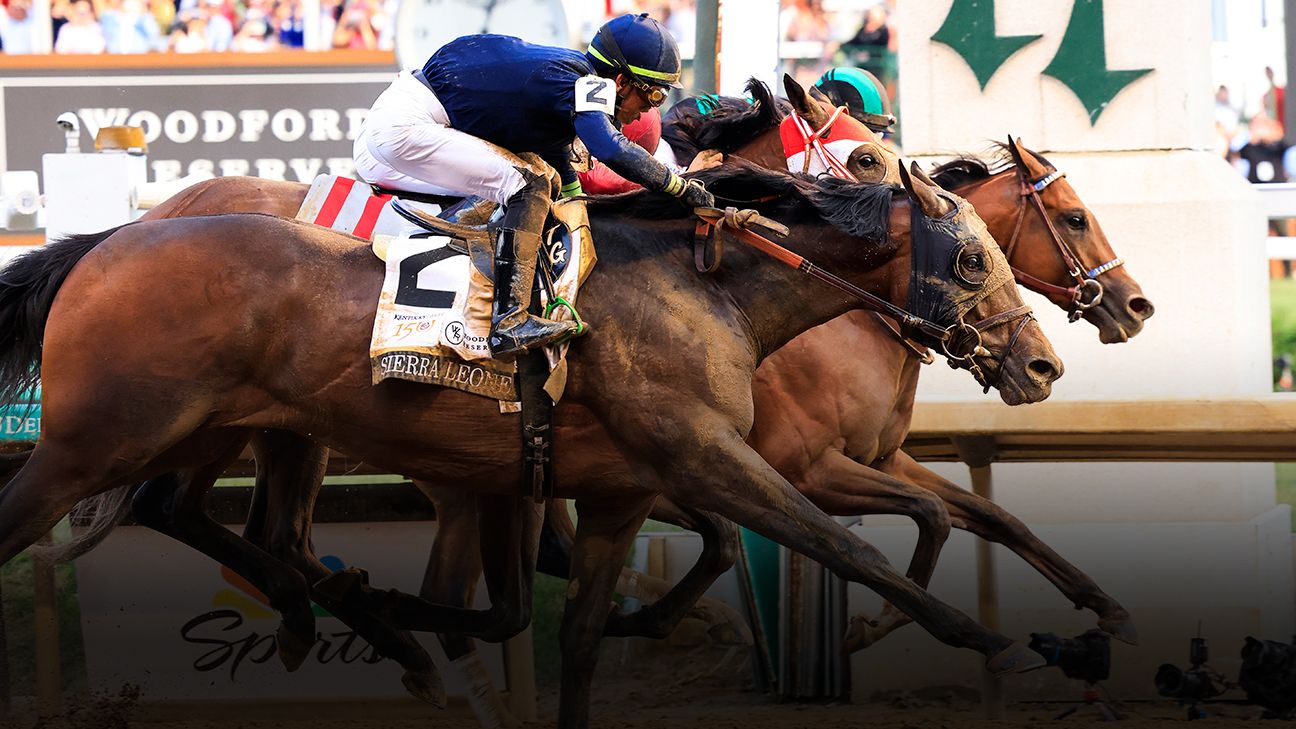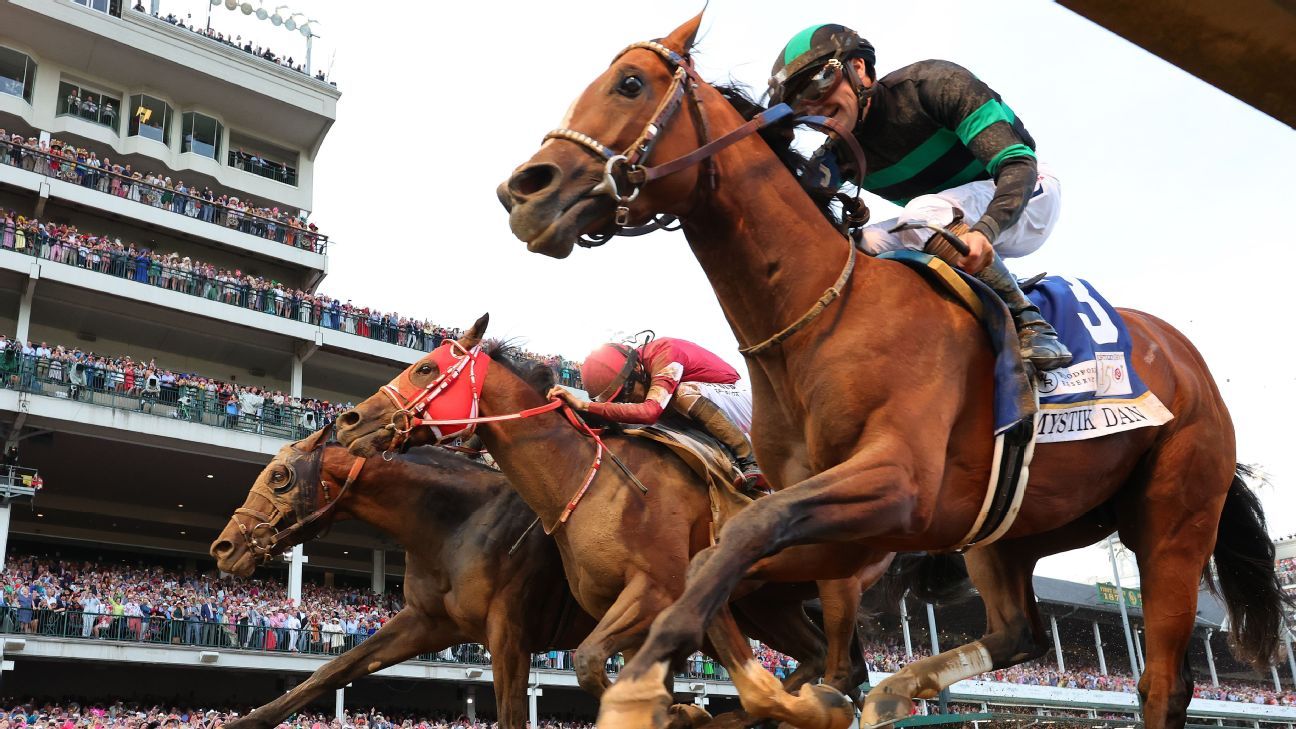
ON A WARM September night last year, after a 27-10 UCF win over Georgia Tech, the crowd hung around to see something that only happens at the Bounce House.
Shortly after the game ended, a SpaceX Falcon 9 lifted off from the Kennedy Space Center, about 35 miles due east from campus in Cape Canaveral, Florida, at NASA’s Launch Complex 39A.
Fans in the stadium got a perfect view of the launch because, by design, UCF’s 50-yard-line sits on the same latitude as the launch pad. As Elton John’s “Rocket Man” played over the stadium speakers, the video board showed a close-up of the spacecraft as it left the Earth’s atmosphere, with fans cheering along. Just another day at SpaceU.
UCF is all-in on space. Founded in 1963 as Florida Technological University with the motto “Reach For The Stars,” it opened in 1968 with an emphasis on providing talent for America’s ambitious space program. Now, with UCF grads making up about 30% of all Kennedy Space Center employees, the university is proudly touting its space connections.
To celebrate that legacy, the football team has played a wildly popular “Space Game” every year since 2017, featuring alternate uniforms with their own distinct color — called Canaveral Blue to reflect the coastal skies and water — and a small nod to the school’s original mascot, the Citronaut, a Florida orange wearing a space suit. It’s one of the coolest modern traditions in college football.
But it did raise the eyebrows of a new conference foe.
“Some blue unis … Some Space City thing,” Houston coach Dana Holgorsen said last week during his radio show. “I thought we were Space City.”
Houston, which is playing its first season in the Big 12 alongside UCF, represents a city that has long taken pride in its role as NASA’s nerve center at Johnson Space Center. Around the same time that UCF was being constructed, Houston was building the Astrodome, home to the Astros and another newfangled invention, Astroturf. (The Houston Rockets were actually named while the franchise was based in San Diego, oddly enough.)
So you’ll forgive Holgorsen if he needs to be educated when he’s told that UCF’s claim as a space hub is due to its proximity to NASA’s Launch Control Center, when Houston is home to Mission Control, the site of one of the most famous lines in the history of the space race.
“They don’t say ‘Orlando, we’ve got a problem,'” Holgorsen said.
With the upcoming departures of Texas and Oklahoma, two of the most storied teams in college football, the Big 12 is desperately in need of some new squabbles. Arizona and Arizona State will arrive next year with the Territorial Cup on the line. BYU, a new addition this year, will reunite with Utah next year in a rivalry that’s been played 101 times.
But while UCF and Houston might not ever become a heated rivalry due to their geographic separation on Earth, there’s a whole other frontier in the heavens. There is real school pride at stake. UCF fans are still rolling their eyes over the short-lived so-called “Civil ConFLiCT” that was forced upon them by UConn and essentially ended when the trophy went missing after two games.
While Houston and UCF have played each other 10 times, none before 2005, this one means something due to their connective tissue with the space program, not to mention they’re now conference opponents.
“We’re embracing it now,” UCF coach Gus Malzahn said earlier this year. “Every one of our roads on campus is named after a galaxy. The first month I got the job, I actually spoke to NASA on leadership and they had me Zoomed in to both groups [in Florida and Texas].”
And the eye in the sky is watching them as well.
“NASA has Space Act agreements with both schools,” said Wayne Saxer, the agency’s lead for sports engagement. “We work collaboratively with universities nationwide that bring innovative solutions and fresh perspectives to some of our biggest challenges.”
To celebrate both schools’ roles supporting America’s space agency, NASA flew a newly minted medallion featuring the logos of each school on opposing sides on CRS-29, a SpaceX mission to the International Space Station a couple of months ago.
Launched from Florida, guided by Houston, the medallion will come back to Earth, where it will be framed and presented to the winning team.
Welcome to the Space Wars.
THE TENSION BETWEEN the folks in Houston and Orlando nearly predates the cities themselves. It reaches back almost a century before the United States entered space with the launch of the Explorer I satellite on February 1, 1958, from Cape Canaveral Launch Complex 26.
In 1865, Jules Verne published “From the Earth to the Moon”, a tale of post-Civil War Americans who construct a spacecraft and launching device to fling a trio of travelers off this mortal coil and toward our nearest celestial neighbor. The French novelist was renowned for his imagination, but also for the research that kept his stories rooted in fact. He always included just the right amount of actual science to make his fantastical fiction seem plausible.
The book’s 10th chapter is titled “Florida and Texas.” Why? Because Verne predicted that the best location for a launch site would be between the equator and the 28th parallel, keeping it best in line with the Moon’s orbital path. Plus, the launch site would need to be built alongside a large body of water, so that debris wouldn’t fall into populated areas in the case of an accident.
With all that in mind, Verne writes about sparring would-be locations in Galveston Bay and “Tampa Town,” complete with lobbying of the government to land the launch pad, protests and rallies in the streets and barbs publicly traded between the two states.
Verne imagined Florida newspapers writing of Texas: “A fine bay; half-choked with sand!” And Texas responding: “Choked yourselves!”
Everything Verne wrote from his home in northern France became a reality nearly 100 years later and 5,000 miles away. NASA was founded after that Explorer I launch and established its primary launch location at the Cape, where the first version of Mission Control was housed in bunkers around the spaceport.
“It was basically a bunch of monitors and microphones in a pillbox,” John Glenn, an original seven Mercury astronaut-turned-U.S. Senator, recalled in 2014. “When we were assigned to CapCom, to talk to our colleague inside the spacecraft, to be in there at the Cape and feel those rockets going up right there and then in front of you, it was remarkable on every level. But it was cramped for space. And yes, I realize the irony of using that word just now.”
On Sept. 12, 1962, John F. Kennedy doubled down on a challenge that he had first pitched to a joint session of Congress one year earlier, that an American should set foot on the Moon before decade’s end. He said those words — in Houston — while standing on the field at Rice Stadium, famously adding: “But why, some say, the Moon? Why choose this as our goal? And they may well ask, why climb the highest mountain? Why, 35 years ago, fly the Atlantic? Why does Rice play Texas? … We choose to go to the Moon in this decade and do the other things, not because they are easy, but because they are hard.”
Once Kennedy announced his moonshot, a literal overnight fight began regarding the location of NASA’s new HQ, the spot for Mission Control. Those already living in Florida believed it should stay there — NASA could simply construct some new buildings — but they found themselves battling dozens of cities for NASA’s favor. Cities from St. Louis to Langley, Virginia, to San Francisco to Shreveport, Louisiana, submitted HQ proposals.
“My favorite was Bogalusa, Louisiana,” says Rick Houston, NASCAR sportswriter-turned-NASA historian and co-author of “Go, Flight! The Unsung Heroes of Mission Control.” “Can you imagine that one? ‘Bogalusa, we’ve have a problem.'”
As part of the region’s push to prove its worthiness, Florida governor Farris Bryant signed into law Senate Bill No. 125, creating a new state university in east central Florida with the goal of supporting the Cape. The school was named Florida Tech, and though it had no sports teams yet, it did have a mascot, a helmet-wearing Jetsons-inspired spaceman with a Florida orange for a body. They called him the Citronaut.
“I love the Citronaut,” confesses Tennessee athletic director Danny White, who served in the same capacity at the school Florida Tech became, UCF, from 2015 to 2021. White, who moved his office into the football stadium where he could watch rocket launches going up from the Cape, greenlit the Citronaut’s return for UCF’s first Space Games in 2018 and ’19. “The instant you see him, you feel like you’re back in the 1960’s Space Age.”
The end result was a punt. Launch operations would remain at the Cape and with it Launch Control at Kennedy Space Center. But that setup didn’t last for long. Beginning with the Gemini 4 flight of June 1965, communication and control shifted to Mission Control, located on the seemingly endless grounds of Johnson Space Center in Clear Lake, Texas, directly in between Houston and Jules Verne’s Galveston Bay. What made the shift happen? A lot of, well, space that was handed to NASA for free via a donation by the same school where JFK’s speech is still memorialized on a plaque that hangs in the stadium where JT Daniels will spend his weekend fighting for a sixth win and bowl eligibility against Florida Atlantic.
“I mean, I don’t want to rain on anyone’s parade here, but if we are talking about space schools, then there’s really one, right?” astronaut Shannon Walker half-joked earlier this year. Walker is a Houston native who has spent 330 days in orbit and holds three degrees from Rice, one of the school’s 13 astronauts. “Go Owls.”
When asked if there is still beef between the Cape and Houston about the decision to move Mission Control west, Rick Houston audibly huffs. “When I was working on my book and interviewing all of the NASA legends, the Florida guys all said the same thing to me. ‘Now, when are you going to write a book about the real Mission Control?'”
HOUSTON, OF COURSE, has a problem with this.
For more than 50 years, the university system has partnered with NASA, including creating a campus in Clear Lake adjacent to Johnson Space Center since its opening in 1961 “to meet a vital demand for trained engineers, physicists and mathematicians to join the U.S. space program,” according to the university.
Last year, Houston chancellor Renu Khator signed an extension with NASA for all the system’s universities to extend a partnership to “advance human spaceflight.”
“Houston is ‘Space City,’ so it’s important for students and faculty in relevant disciplines across the UH system to have opportunities to engage in and be exposed to real-world space flight-related research and technology development with NASA,” Khator said.
Dr. Olga Bannova, formerly an architect in Moscow, is the director of Houston’s Sasakawa Center for Space Architecture, the only master’s level program of its kind in the world.
“It’s obviously about human spaceflight, but also about psychology,” Dr. Bannova said. “It’s about understanding human needs and providing and thinking about the ways how we can make a human life not only sustainable in space, but also really rewarding, you know?”
One of those ways, Bannova says, is to provide “a complementary countermeasure against all these negative effects on the human physiology and psychology that’s associated with microgravity conditions.”
For those of us who don’t speak scientist, basically that means one component is the possibility of sports in space.
Adam Doll, one of Bannova’s graduate students, is already an engineer for NASA in Houston who does astronaut training and when he’s not pondering spacesuit development, is working on his master’s thesis on the idea of collaborative sports in some interstellar habitat. Nothing too rowdy. Think a collaborative rock climbing-type course with an objective to complete it as fast as possible. Not a future Cougars-Knights battle in the cosmos.
“You don’t want the games to get too competitive in space,” Doll said.
But down here, it’s all fair game.
“I don’t even know where UCF is, to be honest. And we have the astronauts in Houston,” Doll said. “That’s a big thing. They live here and train here. They just go out there [to Florida] to launch. I mean, they only use that every once in a while. Mission Control is manned 24/7. We always have people monitoring the space station.”
That would explain why legendary NASA flight director Gene Kranz, who oversaw the Mercury, Gemini and Apollo programs, including the first moon landing (and was portrayed by Ed Harris in “Apollo 13”), said the Florida-Texas grandstanding has evolved over the years.
“That may be a current-day rivalry, but that was not the case back through the programs that I supported,” Kranz, who is 90 and lives near Houston, said. “I think it may have come about once we started putting astronauts as center directors down at the Cape.”
No matter which side you’re on, the Knights are way ahead in embracing the SpaceU moniker. Every single sport at UCF has an alternate SpaceU/Citronauts jersey. And it’s good for business.
“Every year, people want to see when the first game is and then when the Space Game is,” said Jimmy Skiles, one of the senior athletic directors at UCF and the chief branding officer. “It’s become just this whole event in itself. I think we are the only college fan base in the country that is willing to accept an alternate mascot and alternate color and even an alternate name for the university — SpaceU — for a single game.”
It’s evident annually, seeing a split fan base wearing black and gold and another huge section of the stadium wearing blue, such as during the 45-3 upset of Oklahoma State two weeks ago.
“That’s never been one of our colors,” Skiles said. “It’s a color we created as part of our space brand. And yet we had 25,000 people wearing Canaveral Blue.” Skiles said eight of their top 10 best-selling merchandise items each year are all space-related.
The other thing fans love about the Space Game? UCF dominates every time. This year, a 4-5 UCF team that had just one Big 12 win crushed No. 15 OSU, moving to 7-0 all time in Space Games with a 202-point margin of victory. Fans switch from “Go Knights!” to “Go ‘Nauts!” for the annual event. It’s almost enough to start an identity crisis.
can ‘Naut lose
+202 point differential all-time in Space Games pic.twitter.com/MtdLIR5Kk5
— UCF Football (@UCF_Football) November 12, 2023
“Our whole fan base accepts the switch on the Space U/Citronauts thing, but so many people are like, ‘It’s time to rebrand to Citronauts full time,” Skiles said. “And then you have the Knights loyalists that are like, ‘Absolutely not, we are Knights. Our colors are black and gold.'”
Whatever they’re called, Houston isn’t giving up the Space City name, and UCF isn’t giving up the SpaceU name. And UCF is ready for Houston to hold up its end of the bargain in the burgeoning rivalry.
Skiles said in 2019, UCF approached UH to invite them to do their own alternate uniforms for UCFs’ Space Game when the Cougars visited Orlando. He knew he probably didn’t give Houston enough time to go all in, but he thought maybe they’d do a themed helmet, like UCF did with its hand-painted helmets resembling the moon’s dark and light sides, complete with craters.
“That was the 50th year of Apollo mission, the moon landing,” Skiles said. “We thought it’d be a really cool thing to have both of us do something. And it came game week and Houston didn’t do it.”
This time around, Houston is excited about visiting UCF as conference rivals, perhaps with a future trophy on the line.
“It is something we’re tracking on, trust me,” Houston athletic director Chris Pezman said. “It’s logical. It should have happened a long, long time ago. It’s something we’ve been working on for a few years. Now it’s time to get it going.”
Eric DeSalvo, UCF’s associate athletic director for content, remembers when he was a student at the school between 2005 and 2009 and could feel the ground rumble when space shuttles would launch at Canaveral. Seeing rockets launch from his own stadium never gets old, he said.
“It’s like a core memory you’ll always remember, being able to see a launch with thousands of your favorite fans,” DeSalvo said. “This season opener, we’re beating Kent State and right as the clock expired a [SpaceX] launch was going up. It’s so cool. It’s not every day you get to see that.”
So inside the building at UCF, they were excited to hear Holgorsen’s dig. It felt like liftoff for the two teams’ future in their own space race.
“Dana, where’s this been the whole time?” said Eric DeSalvo, UCF’s associate athletic director for content. “Why’d you wait until last week for that comment? We needed this.”













